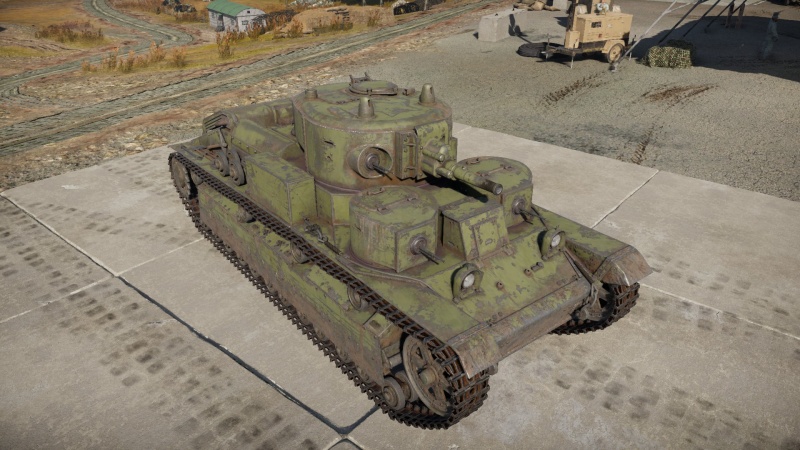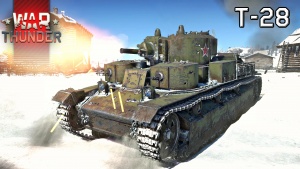Difference between revisions of "T-28"
Colok76286 (talk | contribs) (→Media: Added skins) |
Colok76286 (talk | contribs) (Added TankManufacturer template) |
||
| Line 263: | Line 263: | ||
* [[wikipedia:T-28|[Wikipedia] T-28]] | * [[wikipedia:T-28|[Wikipedia] T-28]] | ||
| + | {{TankManufacturer Kirov}} | ||
{{USSR medium tanks}} | {{USSR medium tanks}} | ||
Revision as of 20:22, 24 September 2022
| This page is about the Soviet medium tank T-28. For other versions, see T-28 (Family). |
Contents
Description
The T-28 is a rank I Soviet medium tank with a battle rating of 1.7 (AB/RB/SB). It was introduced during the Closed Beta Test for Ground Forces before Update 1.41. An unorthodox medium tank with three turrets, it is quite mobile and armed with a 76 mm gun to defend itself against its contemporaries. It may look big, but the T-28 is surprisingly agile and the roomy inside will turn many small calibre APHE shells into hot-air.
General info
Survivability and armour
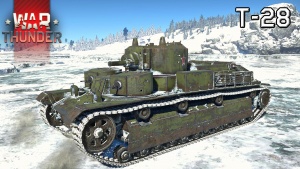
Despite being a medium tank the T-28 is somewhat lightly armoured for its BR, alongside than the crew is closely packed and surrounded by ammo racks that will be prone to detonation if hit, this leads to it having somewhat weak survivability, however angling the vehicle will increase the effectiveness of the armour and aid in your survivability.
Armour type:
- Rolled homogeneous armour
- Case homogeneous armour (Gun mantlet)
| Armour | Front | Sides | Rear | Roof |
|---|---|---|---|---|
| Hull | 30 mm (22°) Driver's port 15 mm (65°) Front glacis 30 mm (23-25°) Lower glacis |
20 mm Top 20 + 10 mm Bottom |
15 mm (68°) Top 20 mm (6-37°) Bottom |
15 mm |
| Main Turret | 20 mm Turret front 20 mm (0-49°) Gun mantlet |
20 mm (0-23°) | 30 mm | 15 mm |
| Secondary Turrets | 22 mm | 20 mm | 20 mm | 10 mm |
Notes:
- Suspension wheels are 10 mm thick while tracks are 20 mm thick.
Mobility
| Game Mode | Max Speed (km/h) | Weight (tons) | Engine power (horsepower) | Power-to-weight ratio (hp/ton) | |||
|---|---|---|---|---|---|---|---|
| Forward | Reverse | Stock | Upgraded | Stock | Upgraded | ||
| Arcade | 43 | 8 | 25.4 | 775 | 954 | 30.51 | 37.56 |
| Realistic | 39 | 8 | 442 | 500 | 17.4 | 19.69 | |
Despite its fair weight the T-28 has decent mobility, the vehicle can easily move around the map to capture points or to attack enemy positions, the vehicle weighs 25.4 tons with an engine producing 500 hp giving the T-28 19.6 hp per ton.
Modifications and economy
- Parts - Mandatory first upgrade, then whatever else.
- BR-350A Ammo! - Without it, the T-28 won't be able to defeat the armour of half the tanks it'll meet
- Adjustment of Fire AND Fire Extinguisher - to improve accuracy, or have the ability to put out fires
- Anything else, but upgrades that improve mobility are advised
Armaments
Main armament
The Main armament of the T-28 is the 76mm L-10 cannon, this is a rifled gun that can fire 3 types of ammunition: High explosive (HE)(OF-350M), Armour-Piercing High Explosive Ballistic Capped (APHEBC)(BR-350A) & a Shrapnel round (Sh-354T), The most common anti tank would be the APHEBC, however the Shrapnel and HE can be used against lightly or unarmoured vehicles.
| 76 mm L-10 | Turret rotation speed (°/s) | Reloading rate (seconds) | |||||||||||
|---|---|---|---|---|---|---|---|---|---|---|---|---|---|
| Mode | Capacity | Vertical | Horizontal | Stabilizer | Stock | Upgraded | Full | Expert | Aced | Stock | Full | Expert | Aced |
| Arcade | 69 | -5°/+25° | ±180° | N/A | 14.28 | 19.76 | 24.00 | 26.54 | 28.24 | 6.50 | 5.75 | 5.30 | 5.00 |
| Realistic | 8.92 | 10.50 | 12.75 | 14.10 | 15.00 | ||||||||
Ammunition
| Penetration statistics | |||||||
|---|---|---|---|---|---|---|---|
| Ammunition | Type of warhead |
Penetration @ 0° Angle of Attack (mm) | |||||
| 10 m | 100 m | 500 m | 1,000 m | 1,500 m | 2,000 m | ||
| Sh-354T | Shrapnel | 34 | 33 | 30 | 24 | 20 | 10 |
| BR-350A (MD-5 fuze) | APHEBC | 67 | 66 | 59 | 52 | 46 | 41 |
| OF-350M | HE | 10 | 10 | 10 | 10 | 10 | 10 |
| Shell details | |||||||||
|---|---|---|---|---|---|---|---|---|---|
| Ammunition | Type of warhead |
Velocity (m/s) |
Projectile Mass (kg) |
Fuse delay (m) |
Fuse sensitivity (mm) |
Explosive Mass (TNT equivalent) (g) |
Ricochet | ||
| 0% | 50% | 100% | |||||||
| Sh-354T | Shrapnel | 560 | 6.2 | 0.5 | 8.0 | 85 | 62° | 69° | 73° |
| BR-350A (MD-5 fuze) | APHEBC | 555 | 6.3 | 1.2 | 14 | 150 | 48° | 63° | 71° |
| OF-350M | HE | 560 | 6.2 | 0.05 | 0.1 | 621 | 79° | 80° | 81° |
Ammo racks
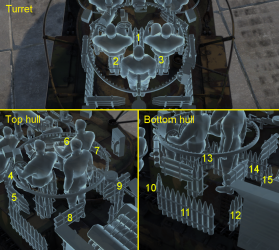
| Full ammo |
1st rack empty |
2nd rack empty |
3rd rack empty |
4th rack empty |
5th rack empty |
6th rack empty |
7th rack empty |
8th rack empty |
|---|---|---|---|---|---|---|---|---|
| 69 | 62 (+7) | 56 (+13) | 50 (+19) | 47 (+22) | 44 (+25) | 41 (+28) | 39 (+30) | 36 (+33) |
| 9th rack empty |
10th rack empty |
11th rack empty |
12th rack empty |
13th rack empty |
14th rack empty |
15th rack empty |
Visual discrepancy |
|
| 33 (+36) | 30 (+39) | 20 (+49) | 17 (+52) | 14 (+55) | 4 (+65) | 1 (+68) | No |
Notes:
- Shells are modeled individually and disappear after having been shot or loaded.
- If you pack 50 (+19) shells, it will keep the turret empty of ammo.
- If you pack 33 (+36) shells, it will keep the turret and the top hull empty of ammo.
Machine guns
| 7.62 mm DT | ||||
|---|---|---|---|---|
| Mount | Capacity (Belt) | Fire rate | Vertical | Horizontal |
| Coaxial | 2,646 (63) | 600 | ±15° | ±15° |
| Left turret | 2,646 (63) | 600 | -5°/+28° | -155°/+5° |
| Right turret | 2,646 (63) | 600 | -5°/+28° | -33°/+145° |
Usage in battles
The powerful, yet accurate gun, paired with thin armour and a large profile makes the T-28 look ideal for long-range encounters, yet its low penetration, slow shell velocity and no real gun depression to exploit terrain discourages this kind of gameplay. However, due to the crew/equipment spacing that helps soak damage and keep it fighting, its highly versatile and powerful main gun make this tank quite capable in close range encounters. Hit & run tactics work pretty well (if the "run" aspect of it is ever needed).
If against a larger or more powerful tank, the T-28 will often be forced to stay and fight, as the large profile of the tank makes it easy to hit while retreating. Use the gun's accuracy to an advantage. Aim for weak points like the driver's hatch or gunner's port. If unable to shoot against such a small target, attempt to cripple the tank's offensive armament to take some pressure off.
Avoid T-34s, especially the later modifications. Their APHE ammo is devastatingly explosive, especially against such a large easy-to-hit tank with no real armour like the T-28. One shot almost anywhere into the tank and that's the end. At the same time, the T-34's own armour is basically invulnerable to the T-28 shells, except when on their sides, where the 76 mm can penetrate the turret, and possibly the side hull armour (Only with AP ammo). Keep in mind that T-34s can turn both their hull and turret very fast, so if the first shot misses, there won't be another chance.
Light tanks that can flank around the side or back of the T-28 can prove catastrophic as well.
Pros and cons
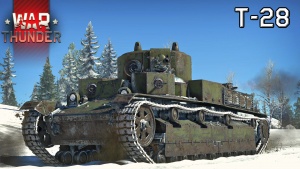
Pros:
- The cannon is accurate and is able to do large amounts of damage on penetration
- Crew of six
- Fast and versatile for such a big medium tank
- Machine gun turrets and complicated multi-layer side armour often absorb projectiles
- It has Shrapnel as standard ammunition, which is effective against light tanks and AA vehicles
- Total of 3 machine guns can make short work of any unarmoured AA vehicles
Cons:
- Large silhouette
- Generally thin armour
- Slow reload time
- Poor gun depression
- Bad penetration with all types of ammo
- Stock ammo types can't penetrate heavy tanks
History
Development
Prerequisites set up in 1929 called for infantry support and breakthrough tank that are able to exploit breakthroughs and handle infantry fortifications. The development of this tank under Chief engineer S.Ginsburg may have been inspired by the British Vickers A1E1 Independent tank as the final design took some elements of it. The end result was a multi-turreted medium tank with a 76.2 mm L-10 main gun and two 7.62 mm machine gun turrets in front. The design was satisfactory that Stalin himself ordered a heavier variant of the tank that can suit the breakthrough role, which would be the T-35. The first multi-turreted was designated the T-28 and was considered revolutionary for the time as it was the first medium tank of its kind and would establish the concept of such tanks. The first prototype of the T-28 was created sometime in 1931, its design was considered revolutionary for the time as it was one of the first medium tanks in the world. Production of this tank began in the Kirov Factory in Leningrad sometime in 1932, and it was accepted into service on August 11, 1933. Though in service for eight years from 1933 to 1941, only 503 units were produced.
Design
The T-28 was relatively slow for its weight at 28 tons, but as an infantry tank, this disadvantage was mitigated by its role and its heavier armour. The front two turrets with machine guns are installed in front of the main turret, which was considerably higher. The main turret was a shared feature from the T-35 in order to standardize parts in production. The tank was initially to be armed with a 45 mm gun like the BT and T-26 light tanks, but the larger 76.2 mm howitzer was chosen instead for added explosive power. The turret had a turret basket and a rear-facing machine gun. A later upgrade had a commander's cupola added onto the turret plus the capability to mount another machine gun on top for anti-aircraft purposes. The tank had a crew of six (driver, two machine gunners, loader, gunner, commander) and ran on a V12 M17 air-cooled engine that can deliver 500 horsepower. Though providing enough power to propel the T-28 at a speed of about 37 km/h (22 mph), the gasoline fuel it used was flammable and rare in Soviet usage. The armour on the tank was 30 mm maximum on the front and side glacis, which was sufficient enough to stop most anti-tank armament at the time. The suspension on the tank was a bogie system with plunger springs and usually has a 20 mm thick side skirt protecting the sides. Transmission and engine compartment is at the very rear under a canopy for easy access. At its introduction in 1933, the T-28 was one of the most effective tanks in the world and had a few innovations. Other countries only had WWI-era Renaults and the Germans had no tanks of their own at its development. The T-28 was also the first to have radios and anti-aircraft gun mounts.
Combat usage
The standard organization of the T-28 tanks in 1939 was 136 T-28s and 47 BT-7 in one heavy armoured brigade. The T-28s were first deployed on the eastern borders during the border clashes with Japan in 1939. The first large scale action was in September 1939 when the Soviet Union invades Poland with its front line fleet of T-28s. Though the Polish tanks and anti-tank guns were able to take out a few T-28s, it is not known how many were lost. The next conflict the T-28 served in was the Winter War against Finland. These tanks were used against Finnish fortifications, but the conflict also showed the inadequate armour on the T-28, where Finnish anti-tank guns were able to reliably penetrate the tanks. Though over 200 T-28s were knocked out in the conflict, only 20 were totally lost due to the system of armour recovery and repairs the Soviet had and the conflict's close proximity to the Kirov Factory, some tanks were repaired more than five times and sent back to the front. The Finnish were able to capture seven of these (two in the Winter War, 5 in Continuation War)and used them against their users. The Finnish came about to nicknaming them Postivaunu ("mail coach") after an incident where a T-28 commander was captured carrying the salary and mail for the 91st Tank Battalion and Kivitalo ("stone building") for its large size. The heavy weight of the tank caused the Finnish to be unable to tow some of the knocked out T-28s for capture, so those unable to be recovered were stripped of their equipment.
After Finland, the T-28's inadequate armour was showcased to the Soviets and an attempt at up-armouring the design was made in 1940 with the welding of additional armour plating to increase the 30 mm armour to 80 mm of armour in thickness. This increase in armour made the tank now weigh 32 tons. This up armouring of the tank was designated the T-28E.
During the German invasion in Operation Barbarossa in mid-1941, the Soviets had about 411 T-28s in their inventory. Many were lost not due to battle, but actually from mechanical breakdowns due to lack of spare parts and low maintenance, causing them to be abandoned by the crew. The Germans were able to capture at least two of these tanks and may have used these against the Soviets as the T-28 746(r). The T-28s that were not lost during the first few months of Operation Barbarossa took part in winter defence of Leningrad and Moscow. Though still in inventory, by 1942 they were rare in Soviet service and declared obsolete as better tanks like the T-34 was taking over its role and is more heavily gunned, more armoured, and faster. The tanks still in one piece were dismantled for spare parts or sent to training facilities.
In-game description
The T-28 was put into service in the Red Army in August 1933 and produced by the Leningrad Kirovsk factory right up until 1940. Over 550 of them were built in total.
A main feature of the tank was its three armed rotating turrets. The main turret in the middle of the tank was equipped with a 76.2 mm KT-28 cannon and two DT machine guns. The turret could turn 360° and was equipped with electric drive. Two smaller turrets armed with machine guns were located in front of the main turret. Each of these turrets could fire across a 220° arc. Starting from 1938, the tank began to be equipped with a 76 mm L-10 cannon.
Combat experience with the tank in the war with Finland led to its armour being strengthened by laying additional armour plates on its base armour and to manufacturing the vehicle with conical turrets, providing better protection against the enemy's weapons. Some late production vehicles were equipped with a DT anti-aircraft machine gun.
In spite of its relatively large mass at 27.8 tonnes, the tank had good mobility due to its reduced ground pressure. Its small-diameter road wheels were covered by add-on armour plates.
With all its primary combat characteristics put together, the T-28 was the strongest medium tank in the world in the 1930s. At the beginning of its production, it had practically no equal among mass-produced tanks. At the same time, the tank was a very complex vehicle with an outdated armament layout. It had serious flaws in its engine and transmission system. The undercarriage wore out rapidly: the springs snapped, parts of the suspension failed, and the hub drive cogs broke.
Vehicles of this type were used in combat operations at the beginning of the Great Patriotic War. The tanks were used in separate battle units on the Leningrad front until 1943.
A Finnish tank brigade captured and operated 7 of these tanks right up until 1945.
Media
- Skins
- Videos
See also
Links to the articles on the War Thunder Wiki that you think will be useful for the reader, for example:
- reference to the series of the vehicles;
- links to approximate analogues of other nations and research trees.
External links
| Leningrad Kirov Plant (Ленинградский Кировский Завод) | |
|---|---|
| Medium Tanks | |
| T-28 | T-28 (1938) · T-28 · T-28E |
| T-80 | T-80B · T-80U · T-80UK · T-80BVM |
| Heavy Tanks | |
| KV-1 | KV-1 (L-11) · KV-1 (ZiS-5) · KV-1E · KV-1S |
| KV-2 | KV-2 (1939) · KV-2 (1940) · KV-2 (ZiS-6) |
| Other | SMK · KV-220 · IS-7 · Object 279 |
| Captured | |
| KV | ▀KV-IB · ▀KW I C 756 (r) · ▀KW II 754 (r) |
| Other | T-28 (Sweden) |
| Export | T-80U (Sweden) |
| See Also | Chelyabinsk Tractor Plant |
| USSR medium tanks | |
|---|---|
| T-28 | T-28 (1938) · T-28 · T-28E |
| T-34-76 | T-34 (Prototype) · T-34 (1940) · T-34 (1941) · T-34 (1st Gv.T.Br.) · T-34 (1942) · T-34E STZ · T-34E |
| T-34-57 | T-34-57 · T-34-57 (1943) |
| T-34-85 | T-34-85 (D-5T) · T-34-85 · T-34-85E |
| T-34-100 | T-34-100 |
| T-44 | T-44 · T-44-100 · T-44-122 |
| T-54 | T-54 (1947) · T-54 (1949) · T-54 (1951) |
| T-55 | TO-55 · T-55A · T-55AM-1 · T-55AMD-1 |
| T-62 | T-62 · T-62M-1 |
| T-64 | Object 435 · T-64A (1971) · T-64B |
| T-72 | T-72A · T-72AV (TURMS-T) · T-72B · T-72B (1989) · T-72B3 · T-72M2 Moderna |
| T-80 | T-80B · T-80U · T-80UD · T-80UK · T-80UM2 · Т-80U-Е1 · T-80BVM · Object 292 |
| T-90 | Т-90А · T-90M |
| Trophies/Lend-Lease | |
| Germany | ▂T-III · ▂T-V |
| Great Britain | ▂МК-IX "Valentine" |
| USA | ▂M3 Medium · ▂M4A2 |



